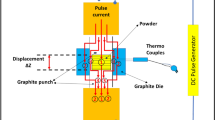Abstract
This paper reports the effect of titanium silicide active filler and the pyrolytic atmosphere (argon and nitrogen) on the ceramic conversion of polycarbosilane. Pyrolysis atmosphere and concentration of titanium silicide active filler was optimized to produce minimum shrinkage polycarbosilane derived ceramic. Detailed investigation on the phase evolution and surface morphology of the titanium silicide incorporated polycarbosilane derived ceramic under different pyrolysis atmospheres were carried out. From the results, it was concluded that 40 wt% titanium silicide loaded PCS system heat treated under nitrogen atmosphere was found to be the best precursor to obtain a minimum shrinkage ceramic phase with better properties. Therefore, this system offers the opportunity to expedite the rapid fabrication process of ceramic matrix composites, create flawless ceramic coatings, and produce bulk ceramic materials free from shrinkage.






















Similar content being viewed by others
Data and code availability
Not Applicable.
References
Somiya S, Inomata Y (2012) Silicon carbide ceramics—1: fundamental and solid reaction. J Mater Sci, Springer Science & Business Media
Khalil NZ, Vajpai SK, Ota M, Ameyama K (2015) Effect of particle size distribution on SiC ceramic sinterability. Mater Trans 56(11):1827–1833
Yajima S, Hayashi J, Omori M (1977) Method for producing organosilicon high molecular weight compounds having silicon and carbon as main skeleton components and said organosilicon high molecular weight compounds. US Patent no. US4052430A
Greil P (1995) Active-filler-controlled pyrolysis of preceramic polymers. J Am Ceram Soc 78(4):835–848
Duan S, Zhu D, Dong J, Lu X, Ding D, Zhou W, Luo F (2019) Enhanced mechanical and microwave absorption properties of SiCf/SiC composite using aluminum powder as active filler. J Alloy Compd 790:58–69
Yang D et al (2011) Fabrication of silicon carbide (SiC) coatings from pyrolysis of polycarbosilane/aluminum. J Inorg Organomet Polym Mater 21:534–540
Makurunje P, Monteverde F, Sigalas I (2017) Self-generating oxidation protective high-temperature glass-ceramic coatings for Cf/C-SiC-TiC-TaC UHTC matrix composites. J Eur Ceram Soc 37(10):3227–3239
Vijay V et al (2016) Influence of titanium silicide active filler on the microstructure evolution of borosiloxane-derived Si-BOC ceramics. J Ceram Sci Technol 7(01):97–106
Vijay V et al (2020) Fabrication and property evaluation of titanium silicide active filler incorporated ceramic matrix composite. Ceram Int 46(13):21489–21495
Maddocks A et al (2008) Heterogeneously catalysed crosslinking of polycarbosilane with divinylbenzene. J Mater Sci 43(8):2666–2674
Krishnan GS, Naveen S, Shahnawaz M, Ramcharan T (2022) Pyrolysis and thermal degradation studies of silane-carbosilane transformation using hyphenated thermal analysis. J Anal Appl Pyrol 164:105535
Holzwarth U, Gibson N (2011) The Scherrer equation versus the Debye-Scherrer equation. Nat Nanotechnol 6(9):534
Zhang Q, Liu H, Qiao T, Withers PJ, Xiao P (2023) Simple and efficient densification of SiCf/SiC composites by gradated concentration polymer infiltration and pyrolysis. Mater Sci Eng A 874:145065
Ferrari AC, Robertson J (2004) Raman spectroscopy of amorphous, nanostructured, diamond–like carbon, and nano diamond. Philos Trans R Soc Lond Ser Math, Phys Eng Sci 362(1824):2477–2512
Roger J, Maillé L, Dourges M-A (2014) Isothermal nitridation kinetics of TiSi2 powders. J Solid State Chem 212:134–140
Amer M et al (1998) The Raman spectrum of Ti3SiC2. J Appl Phys 84(10):5817–5819
Ahmed N, et al (2013) Raman and FTIR studies on PECVD grown ammonia-free amorphous silicon nitride thin films for solar cell applications. Conference Papers in Science, Hindawi
Jauberteau I et al (2017) Silicides and nitrides formation in Ti films coated on Si and exposed to (Ar-N2-H2) expanding plasma. Coatings 7(2):23
Hiraki A, Nicolet MA, Mayer J (1971) Low-temperature migration of silicon in thin layers of gold and platinum. Appl Phys Lett 18(5):178–181
Ren Z, Mujib SB, Singh G (2021) High-temperature properties and applications of Si-based polymer-derived ceramics: a review. Materials 14(3):614
Scheffler M et al (2004) Nickel-catalyzed in situ formation of carbon nanotubes and turbostratic carbon in polymer-derived ceramics. Mater Chem Phys 84(1):131–139
Wang Q et al (2015) Effect of counterparts on the tribological properties of TiCN coatings with low carbon concentration in water lubrication. Wear 328:356–362
Yan M, Song W, Zhao-hui C (2010) Raman spectroscopy studies of the high-temperature evolution of the free carbon phase in polycarbosilane derived SiC ceramics. Ceram Int 36(8):2455–2459
Soraru G, Babonneau F, Mackenzie J (1990) Structural evolutions from polycarbosilane to SiC ceramic. J Mater Sci 25(9):3886–3893
Acknowledgements
The authors thank Director, Vikram Sarabhai Space Centre (VSSC), Thiruvananthapuram, Kerala, India, for ongoing support. The VSCC Editorial board assisted with vetting, and clearances and the VSSC Analytical and Spectroscopy Division provided analytical assistance.
Author information
Authors and Affiliations
Contributions
The authors confirm contribution to the paper as follows: VV contributed to Study conception, Experiments, data collection, analysis, interpretation of results, manuscript preparation SGN contributed to Experiments and data collection RD contributed to Manuscript preparation. All authors reviewed the results and approved the final version of the manuscript.
Corresponding author
Ethics declarations
Conflict of interest
The authors declare that they have no known competing financial interests or personal relationships that could have appeared to influence the work reported in this paper.
Ethical approval
Not Applicable.
Additional information
Handling Editor: Chris Cornelius.
Publisher's Note
Springer Nature remains neutral with regard to jurisdictional claims in published maps and institutional affiliations.
Rights and permissions
Springer Nature or its licensor (e.g. a society or other partner) holds exclusive rights to this article under a publishing agreement with the author(s) or other rightsholder(s); author self-archiving of the accepted manuscript version of this article is solely governed by the terms of such publishing agreement and applicable law.
About this article
Cite this article
Vijay, V.V., Nair, S.G. & Devasia, R. Conversion of polycarbosilane to silicon carbide: effect of an active filler and pyrolysis conditions. J Mater Sci 58, 16046–16062 (2023). https://doi.org/10.1007/s10853-023-09056-4
Received:
Accepted:
Published:
Issue Date:
DOI: https://doi.org/10.1007/s10853-023-09056-4




